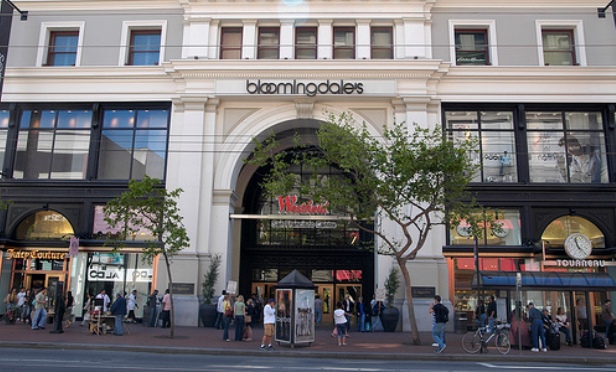 Mall transformations include Bespoke on the fourth floor near Bloomingdale's in the Westfield Center.
Mall transformations include Bespoke on the fourth floor near Bloomingdale's in the Westfield Center.
SAN FRANCISCO—The growth prospects for US malls are brighter than what conventional wisdom suggests about retail's competing forces including the proliferation of e-commerce, according to global alternative investment manager QIC. Successful malls will be those that transform beyond shopping into social town centers, places where people go to eat, meet friends, be entertained, relax or experience an array of other services, according to the firm's Red Paper, “Rhetoric versus reality: Quantifying the long-term outlook for U.S. mall sales”.
This requires a shift in tenant mix toward services, including dining, hotels, entertainment, medical centers, fitness and other personal services to boost sales and produce a more resilient mall. The tenant mix of a genuine town center can more than double the sales growth of a mall that is currently operating with today's typical tenant mix.
“Not all malls are in trouble: class A is holding its own, but the class-C malls are dying and in two years, they will be dead and need to be redeveloped,” Garrick Brown, vice president, Americas head of retail research, Cushman & Wakefield, tells GlobeSt.com. “There are numerous examples of these mall transformations: Bespoke is now on the fourth floor near Bloomingdale's in the Westfield Center in San Francisco, Costco took the former Sears store on the East Coast and WeWork went into Lord & Taylor's flagship New York store.”
QIC agrees, saying with an overexposure to department store anchors, vulnerability to e-commerce, generally poor locations and need for significant capital expenditure, hundreds of lower-quality C and D malls will need to be repurposed or closed during the coming decade. While some of the sales from the closed malls will be lost to e-commerce, a portion will be gained by nearby A and B grade malls.
Higher-quality malls can also benefit from strong growth in inline tenant sales (a primary driver of mall operating income, expected to average 3.4% during the next 10 years) as well as shifting the tenant mix to more Internet-resistant offerings, including experiential services.
“There is no question that bricks-and-mortar retail has endured headwinds, and our physical offer, our stores and our retailers have needed to adjust for new consumer preferences,” says Matthew Strotton, global director of capital with QIC's Global Real Estate investment arm. “But we believe that predictions of the demise of the US mall are overdone. In fact, in our macro and micro analysis of competing factors that impact the sector, we see robust growth for strategically managed A and B grade malls over the coming 10 years. These findings contribute directly into our future planning, including how we view the new retail model as part of an overall town center/mixed use offering.”
In assessing mall sales, the study also develops a more accurate nuanced picture of malls by grade–A, B and C/D.
“Despite the negative headlines around the challenges facing the retail sector, it is important not to lose sight of the many nuanced underlying drivers of mall sales growth,” Strotton says. “With this much more detailed understanding, as well as our ability to actively manage quality assets, we see strong potential to build further value in our US mall portfolio and deliver exceptional outcomes for investors.”
Among the study's key findings, published in August 2018 are:
US macroeconomic factors of low unemployment, rising wages, strong balance sheets and recent tax cuts will drive strong 3.5% annual growth in brick and mortar sales during the next 10 years, even as e-commerce's share of the retail market doubles.
In competing with e-commerce, department stores and stores selling electronics/appliances, sporting goods and books/music will be hardest hit, losing 20% market share during the next decade.
Food services, with little e-commerce penetration, i.e., stores selling food, beverages and other perishables and stores that sell health care products that require in-store services, will fare better. Consumers also prefer entertainment and personal services, fast-growing segments with low levels of e-commerce penetration.
Retailers executing an omni-channel sales strategy can leverage physical space to showcase products, build brand awareness, engage with customers and enable “click and collect” and “click and deliver” services. They can use the advantages of physical retail space in these and other ways to complement, rather than compete against e-commerce.
“In conducting our quantitative analysis of the US retail sector, we employed a top-down and bottom-up approach bringing together and scrutinizing all relevant data, enabling us to present a full view of the sector's outlook,” says Dr. Matthew Peter, QIC's chief economist and the paper's co-author. “This analysis begins at the macroeconomic level by forecasting personal consumption and moves on to look with a microeconomic lens at sales at retail outlets, i.e., bricks-and-mortar and e-commerce, and malls as a whole.”
© Touchpoint Markets, All Rights Reserved. Request academic re-use from www.copyright.com. All other uses, submit a request to [email protected]. For more inforrmation visit Asset & Logo Licensing.







